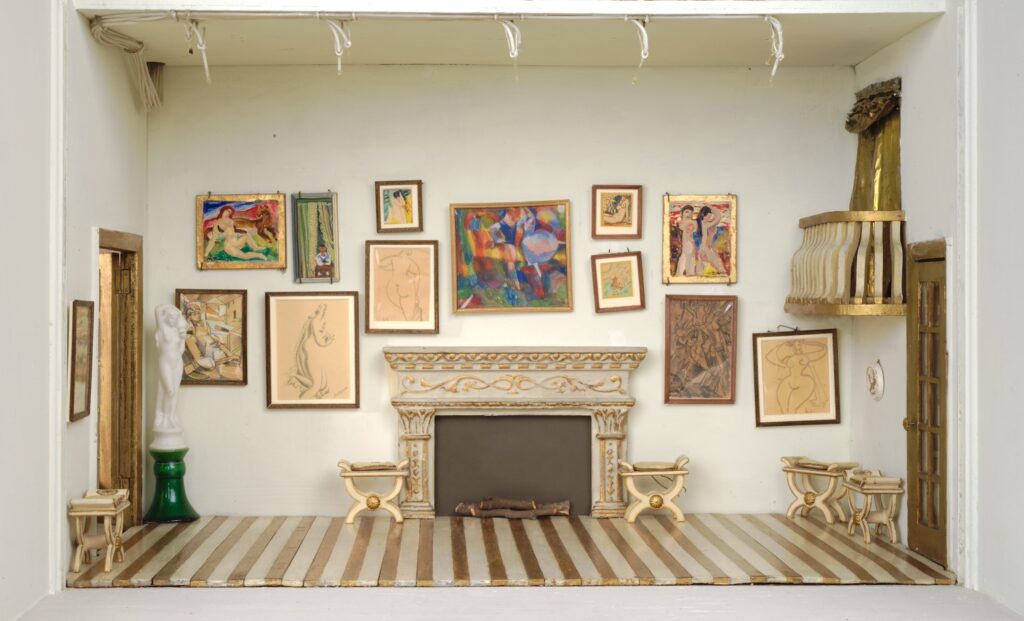Grab a Flashlight and Some Aspirin Before Visiting ‘The Stettheimer Dollhouse in a New Light’ at the Museum of the City of New York
The installation is geared to young children, who will have an ideal vantage point for peering into the nooks-and-crannies of Carrie Stettheimer’s toy-like extravaganza. Grown-ups will have to squint, bend, and crouch.

Let me offer a word of advice to those intending to visit a recently opened exhibition at the Museum of the City of New York, “The Stettheimer Dollhouse in a New Light.” Actually, let me give two words of advice, particularly for gallery-goers whose eyesight and backs are not what they used to be: First, make sure your cellphone is in tow; second, get ready to stoop.
You’ll need the former for its flashlight, as the famed dollhouse has no interior illumination and is rife with eccentricities and details worth taking in. You’ll need to keep the latter in mind because the installation is geared to young children, who will have an ideal vantage point for peering into the nooks-and-crannies of Carrie Stettheimer’s toy-like extravaganza. Grown-ups will have to bend, crouch, and test the resilience of their knees.
Yet who said art had to be easy? It certainly wasn’t Stettheimer (1869-1944), who fine-tuned her elaborate construction over the better part of 20 years. This staple of the museum’s permanent collection has been out of view for two years in order to undergo renovation. The dollhouse has now returned with its own designated exhibition space in this, the 100th anniversary of the museum’s founding. Curator Lily Tuttle heralds the Stettheimer Dollhouse as “a testament to the creativity and cultural vibrancy of its time.”
Who was Carrie Stettheimer? Good luck answering the question without dragging in her sisters, Florine and Ettie, and mother Rosetta. The latter was a scion of a wealthy German-Jewish family who raised five children after her husband, a businessman with little business acumen, Joseph Stettheimer, abandoned the family. Rosetta subsequently shuttled the children between Manhattan and Europe, with two of them, Stella and Walter, leaving the house upon adulthood. Carrie, Florine, and Etta remained at their mother’s side and with each other.

As women of independent means, the Stettheimers were free to pursue their interests and cultivated a social circle of painters, sculptors, poets, and gadflies. Carrie and Rosetta hosted a series of salons at their West 58th Street home and invited talents that were, as history has proved, consequential. These include the painters Charles Demuth and Marsden Hartley; sculptors Gaston Lachaise and Elie Nadelman; an art critic for The New York Sun, Henry McBride; and the grand-père of Dadaism, Marcel Duchamp.
Carrie attended to these heady affairs, as well as the general upkeep of the Stettheimer household, to the extent that she put on hold her aspirations of becoming a theatrical designer. Not so for the youngest and oldest of the sisters. Ettie, working under the pseudonym Henrie Waste, was a published author and philosopher. Florine was a painter working from her immediate social milieu in a manner as flamboyant as it was acidic. The reproductions of Florine’s pictures that dot the MCNY exhibition give only the barest idea of their scrabbled tactility and coloristic punch.
Creative necessity will out, however, and Carrie started construction of the dollhouse in 1916, basing it upon features of the family’s house in Tarrytown and their Manhattan homestead. It’s a two-tiered edifice measuring 28-inches high and containing an abundance of incredibly particular furnishings, including high-end wallpaper, fancy crockery, a hobby horse, architectural filigrees, a vine-covered trellis, and, yes, the kitchen sink. Rumor has it that Carrie once populated these clustered surroundings with plaster figurines. Where could they have been fitted in?
The centerpiece of the Stettheimer Dollhouse is the ballroom in which Carrie asked regular salon attendees to create signature works in miniature that could pepper the walls. Contour drawings of amplitudinous female nudes by Lachaise are readily identifiable, as is a general air of Modernist experimentation. The most recognizable of these mini-masterpieces is Duchamp’s recreation of “Nude Descending A Staircase” (1912), a painting that was still marked by the scandal it caused at the Armory Show of 1913. You’ll see it just to the right of the expansive marble fireplace.
The press release mentions that an Ashcan School painter, George Bellows, also made a contribution to the dollhouse, but damned if I could find it. A return trip to “The Stettheimer Dollhouse in a New Light” is definitely called for — but only after my back recovers from its aches and pains.

